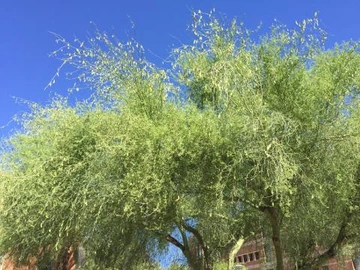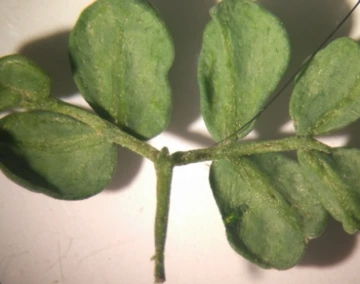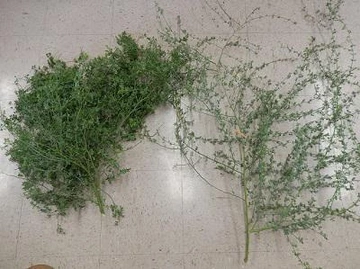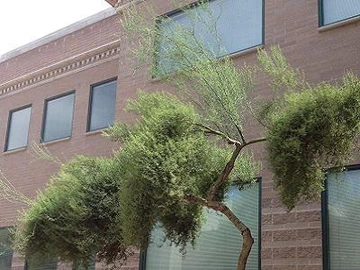The majority of tree and shrub roots occur within the top two feet of soil and extend up to 3 to 5 times the width of the canopy. These roots hold the plant in place and absorb water and nutrients. Proper planting practices reduce establishment time and improve plant survival and stability by supporting the growth of new roots from the transplanted root ball into the surrounding soil. Such steps include preparing the root ball, shallow, wide planting holes, no organic amendments in the backfill, surface mulching, staking if necessary, and proper irrigation.
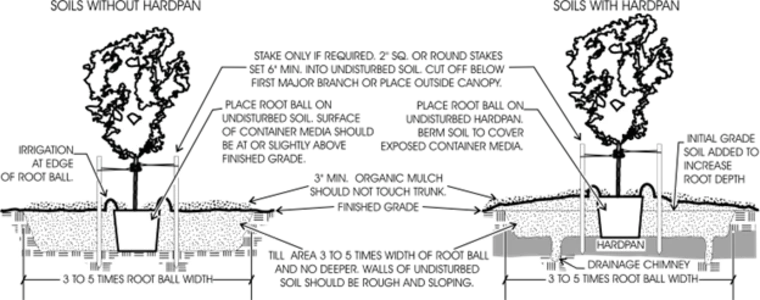
Figure 1: Planting and staking a tree in soil without hardpan (left) and with hardpan (right).
Materials required
Soil
Native soil where trees and shrubs will be planted should be free of construction materials, weeds, and other debris. A soil depth of at least 18 to 24 inches deep supports healthy root growth. Trees and shrubs can be planted on a raised mound by adding soil to increase rooting depth, especially for larger trees. Soil imported to increase depth or to achieve other objectives should be similar in texture to native soil, and free of diseases, pests, weeds, or debris. Placing sandy soil on top of clay soil or vice versa can lead to drainage problems or obstruct root growth. Soil texture can be determined with the jar test (Jeffers, 2023). Cultivating compacted soils to a depth of 8 to 10 inches improves soil properties and root growth.
Soil amendments
Do not add organic amendments, such as manure, compost, or wood chips, to the soil at planting. These amendments do not improve and may inhibit the growth of the plant. Nitrogen is usually lacking in desert soils and is effectively applied to the soil surface a year after planting if needed. If other nutrients are lacking, they can be added at the recommended rates to correct deficiencies.
Plant materials
Select strong, healthy native or desert adapted plant material (Davison et al., 2015). Plant size should be proportional to the size of the container or root system. A desirable tree structure includes a defined single or multiple trunks, depending on the species, well-spaced radial and vertical branches, and trunks not tightly staked. Well-developed root systems maintain a f irm root ball when taken out of the container and are without root girdling or heavy matting at the outside of the container.
Tree stakes and ties
Wood or metal stakes can be used. Tie material to fasten the trunk to the stake should be smooth, wide, and flexible to protect the trunk from physical damage.
Mulch
Suitable surface applied organic mulch materials include shredded bark, wood chips, or coarse compost.
Drainage test
Poor drainage can cause problems because roots are damaged in soils that stay too wet for too long. Conduct a drainage test if the planting soil is shallow, compacted, or has a heavy clay texture.
Test drainage by digging the planting hole, or any area where testing is of interest, approximately one foot deep in dry soil. Fill the hole completely with water twice during the day. Drainage is poor if any water is still standing 24 hours after the second filling.
Chimney holes may improve poor drainage due to a shallow, thin hardpan. These are holes dug through the hardpan (Fig. 1). Dig several chimney holes besides, not beneath, the root ball to avoid irrigation water being funneled quickly through the root ball. Fill these holes with the same soil used in the planting hole, not gravel. Since it is impossible to determine the depth of any hardpan or caliche layer, drainage chimneys may not be practical where these layers are very thick.
Planting
Before planting a tree or shrub, planning which species or cultivar to plant is essential to ensure the plant can thrive in the climate zone and microclimate of the planting location (Davison et al., 2015). The final size of the plant needs to fit the available space; above ground to prevent interference with nearby structures and below ground to develop a healthy root system. Planting the right tree or shrub in the right place supports healthy, thriving landscape plants.
Time of transplanting
Transplanting trees or shrubs is best during the time of year when temperatures are above freezing and conditions are not too hot and dry. This minimizes stress and allows for faster recovery of new transplants.
Planting hole
Dig a hole slightly wider and no deeper than the root ball of the plant to be installed. Ensure the hole is no deeper than the height of the prepared root ball. Loosen the soil around the hole three to four times the width of the hole diameter and no deeper than the root ball. Walls of the undisturbed soil should be rough and sloping outward.
Plant preparation
Always handle the plant by the container or the root ball, never by the trunk or branches. Remove the plant from the container with minimal disturbance to the root ball. Place larger containers on their side and tap the sides and bottom and the root ball can slide out. Remove the nursery stake, labels, and ties. Do not prune branches unnecessarily. Remove only dead, broken, or diseased branches using clean, sharp pruners.
Root ball preparation
Preparing the root ball for planting begins with inspecting the top surface to ensure that the root flare, where the trunk is attached to the root system, is visible and not covered with soil (Urban Tree Foundation, 2014). Circling roots at the surface, especially if close to the trunk, need to be cut. Next, the outside and bottom of the root ball of container or boxed trees is shaved with a sharp blade to remove all roots growing on the outer one inch or more of the periphery (Urban Tree Foundation, 2014). This removes root defects such as circling, girdling, kinked, or matted roots and exposes root tips (Fig. 2), encouraging new root growth into the surrounding soil.
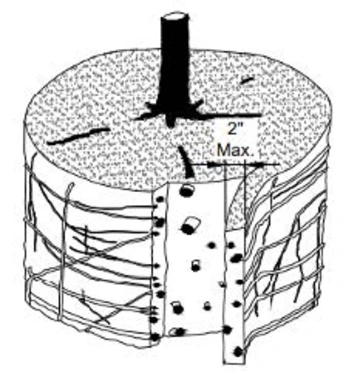
Figure 2: Shaving root ball removes roots on the outside and bottom.
When planting balled and burlapped (B & B) plants, loosen the burlap from around the stem, fold back the burlap and cut back and remove any twine and burlap from the top of the root ball, then backfill with soil. If there is a wire basket around the root ball, remove the top two or three rings of wire from the basket prior to planting.
Planting depth
Trees and shrubs need to be planted at or above grade and should never be planted too deep, which will make them susceptible to disease. Structural roots should be just below the soil surface. All grafted trees should have the graft union where the root stock and the top scion meet, above the final grade.
The top of the root ball should be level with or slightly above the finished grade to avoid crown rots and other problems. Fill the hole with unamended soil, lightly tamp backfill as soil is added to remove air pockets, do not over compact the soil. When about half of the planting hole is filled, slowly add water to soak the root ball and settle the backfill. Continue until the planting hole is filled with soil and water again.
Irrigation
Construct a berm to form an irrigation well, if used, at the edge of the root ball (Fig. 1). Irrigate the root ball and the entire tilled area. Apply enough water to thoroughly wet the soil to the depth of the root ball. This will continue to remove air pockets and is best done by hand watering with a hose if possible. More soil may have to be added after the first irrigation. It is important to put water in the irrigation well for the first few weeks to make sure the root ball is moist. If the irrigation well is wider than the root ball, the original root ball may stay dry even though the surrounding soil is wet. Water every few days to keep the root ball wet and increase intervals between watering, depending on the weather. Expand the irrigation well or install alternative irrigation once roots are growing into the surrounding soil.
Mulching
Mulch the entire tilled area with three to four inches of organic material. Cover the exposed area of the root ball with no more than one inch of mulch and keep mulch away from the trunk. If planting in a lawn, keep the planting area free of grass by either hand weeding or careful applications of herbicide.
Protection from wildlife
Install wildlife guards or fencing as needed to protect the plants against herbivores such as rabbits. Monitor potential damage from underground vertebrate animals such as moles.
Staking trees
Install wildlife guards or fencing as needed to protect the plants against herbivores such as rabbits. Monitor potential damage from underground vertebrate animals such as moles.
Stakes
Two wooden or metal stakes should be installed outside the original plant root ball, to a depth of at least 6 inches into the undisturbed soil. Place them at right angles to the prevailing wind. After installation, cut the stakes off below the canopy to prevent wounds to branches (Figure 1).
Tie material and placement
Smooth, wide, and flexible tie materials are suitable to fasten the tree to the stakes. To determine the height where to place the ties, hold the trunk with one hand a few inches above ground. If the trunk bends over, move up the trunk a few inches and try again. Continue until you find the lowest point on the trunk at which it will not bend and remain upright. Place ties about six inches above this point. Attach one tie around the trunk and to the stake, then repeat with the second tie on the opposite stake, allowing for slight trunk movement. Only one set of ties is needed to stake a tree. Gentle movement of the trunk will help develop trunk caliper, taper, and improve stability of the tree.
Maintenance after planting
Periodically inspect the transplanted tree or shrub for issues such as insects, diseases, or abiotic stress; assess and adjust irrigation applications to maintain optimum growth and plant health. As the tree grows, stakes and tie materials should not interfere with the trunk or branches and should be removed after the first growing season. Fast growing young trees may require pruning to train a strong branch structure. Some trees may benefit from fertilizing after the first growing season. Keeping the root zone free of competing vegetation and maintaining mulch over the area benefits plant growth and development.
Summary
- Choose healthy native or desert adapted plants that are not damaged or overgrown. The final size of the plant needs to fit the available space above ground and below ground.
- Dig a planting hole no deeper than the root ball, conduct a drainage test, loosen the area around the planting hole.
- Prepare the root ball by correcting issues on the soil surface and by shaving the outside periphery of the root ball.
- Install the plant so that the top of the root ball is level with or slightly above the surrounding surface. Remove the nursery stake at planting.
- Use native soil for backfill, do not add soil amendments.
- Stake the tree only if it needs support, anchoring, or protection. Use broad, smooth, flexible tree ties that allow slight movement of the trunk. Remove stakes after one growing season.
- Irrigate during and after planting to settle the soil and remove air pockets from the backfill. Construct a berm or well around the planting hole, water frequently to keep the root ball wet and reduce irrigation frequency until establishment.
- Mulch the disturbed area to a depth of 3-4 inches taking care to keep the mulch material away from the trunk.
- Maintenance of transplants includes regular inspection for plant health, adjustment of irrigation, and assessing the need for pruning, fertilization, and mulching. Install wildlife guards as needed to protect the plants against animal damage.
References
- Davison, E., J. Begeman, J.L. Tipton, and T. DeGomez. 2015. Plant Selection and Selecting Your Plants. Univ. Arizona Coop. Extension Publication AZ1153. https://extension.arizona.edu/sites/default/files/2024-08/az1153-2015.pdf.
- Jeffers, A. 2023. The soil texture analysis ‘The jar test’. Clemson Univ. Factsheet HGIC 1656. https://hgic.clemson.edu/factsheet/soil-texture-analysis-the-jar-test/. Accessed 12/12/2024.
- Schuch, U.K. and J. Kelly. 2011. Selecting, Planting, and Staking Trees. Univ. Arizona Coop. Extension PowerPoint presentation AZ1402. https://extension.arizona.edu/sites/extension.arizona.edu/files/attachment/SelectingPlantingStaking-2.pdf. Accessed 2/10/2025.
- Urban Tree Foundation. 2014. Planting. 28 p. https://www.urbantree.org/pdf_pds/UTF_Planting_Final_Version.pdf. Accessed 2/10/2025.


